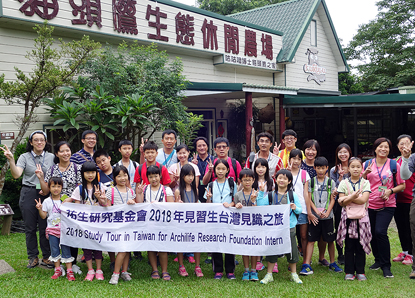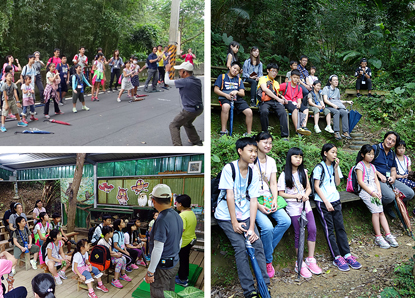Sketch of Archilife Study Tour, September 2018
|
2018年9月份見識之旅縮影  9月份見識之旅活動,於2018年9月15日由呂明澐小姐帶領26位祐生見習生及家長們,進行苗栗獅潭咕咕貓頭鷹奧秘暨蠶寶寶生態知性之旅。活動開始之初,領隊呂明澐小姐提醒本次活動注意事項及觀察重點,先行建立見習生的背景知識。 9月份見識之旅活動,於2018年9月15日由呂明澐小姐帶領26位祐生見習生及家長們,進行苗栗獅潭咕咕貓頭鷹奧秘暨蠶寶寶生態知性之旅。活動開始之初,領隊呂明澐小姐提醒本次活動注意事項及觀察重點,先行建立見習生的背景知識。 For the study tour of September 15, 2018, Ms. Lu Ming-yun led 26 ARF interns and their parents on an ecological tour to learn about owls and silkworms in Shihtan, Miaoli. At the start of the day's activities, team leader Ms. Lu Ming-yun reminded everyone about things to note and what to observe, and gave the interns some background knowledge.  本次上午行程,參訪咕咕博士貓頭鷹之家,由園區主人擔任導覽老師。行程一開始,導覽老師透過投影片,講述該園區係為救援傷病貓頭鷹及其他野生動物而成立,並介紹貓頭鷹的種類特徵與習性,說明在台灣為保育類猛禽,不可私自豢養。導覽老師隨即指出貓頭鷹數量銳減的因素,主要是貓頭鷹誤入為保護農作物設下的鳥網導致傷亡,且田間噴灑之農藥經老鼠等小動物吃下,後遭位於食物鏈頂端的貓頭鷹誤食,使其間接受害。緊接著,以健行方式進行生態巡禮,導覽老師沿途解說周遭環境,提醒途中有標記野生動物蹤跡的告示牌,可觀察其移動路徑。隨後導覽老師闡述一段食蛇龜的故事,更正以往對食蛇龜吃蛇的錯誤印象,並以模型解釋食蛇龜的外觀及構造,教導如何自腹甲凹陷與否分辨性別。接著講述食蛇龜於中國進補市場有大量需求,盜捕走私事件時有所聞,期望藉由本次生態參訪,傳遞野生動物保育及無痕山林的重要性。 本次上午行程,參訪咕咕博士貓頭鷹之家,由園區主人擔任導覽老師。行程一開始,導覽老師透過投影片,講述該園區係為救援傷病貓頭鷹及其他野生動物而成立,並介紹貓頭鷹的種類特徵與習性,說明在台灣為保育類猛禽,不可私自豢養。導覽老師隨即指出貓頭鷹數量銳減的因素,主要是貓頭鷹誤入為保護農作物設下的鳥網導致傷亡,且田間噴灑之農藥經老鼠等小動物吃下,後遭位於食物鏈頂端的貓頭鷹誤食,使其間接受害。緊接著,以健行方式進行生態巡禮,導覽老師沿途解說周遭環境,提醒途中有標記野生動物蹤跡的告示牌,可觀察其移動路徑。隨後導覽老師闡述一段食蛇龜的故事,更正以往對食蛇龜吃蛇的錯誤印象,並以模型解釋食蛇龜的外觀及構造,教導如何自腹甲凹陷與否分辨性別。接著講述食蛇龜於中國進補市場有大量需求,盜捕走私事件時有所聞,期望藉由本次生態參訪,傳遞野生動物保育及無痕山林的重要性。The morning's itinerary brought everyone to Owl Leisure Farm. Guided by the farm's owner, the tour began with a slideshow about the farm, which was established to rescue injured owls and other wild animals. The slideshow also introduced the types, characteristics and habits of owls, and explained that owls are considered protected birds of prey and should not be kept as pets. The guide also explained the reasons for the sharp decline in the number of owls-mainly due to the owls mistakenly entering bird netting installed for crop protection and getting injured or killed, and preying on small animals, such as mice, which have eaten pesticide contaminated crops. During the hike that followed, the guide reminded everyone that signs indicating wild animals along the way would allow them to observe the animals' path of movement. He also told a story about the Chinese box turtle (Cuora flavomarginata), correcting everyone's erroneous impression that it eats snakes, explaining its appearance and anatomy using a model, and teaching everyone how to identify its gender by the dent in its belly. As the Chinese box turtle is used as herbal tonic, it is highly demanded in the China tonic market, and poaching and smuggling are occasionally reported. It is hoped that everyone will learn the importance of wild animal conservation and Leave No Trace through the ecological tour.  中午飯後,前往泉明蠶寶寶生態教育農場。導覽老師首先講述台灣蠶業發展歷史,為眾人建立基本概念。接著展示蠶卵紙,說明該品種蠶卵孵化時間平均為10天,因有越冬性,冬季蠶卵較難孵化,產絲品質亦不佳,通常會冷藏至隔年春夏之季再行孵化。隨後依家蠶的成長階段,詳細解說其所食用的桑葉細嫩程度、脫皮次數及身體差異,亦釐清普遍認為蠶寶寶眼睛所在之處,實為胸部的眼狀斑紋,其眼睛位於頭部(即一般認為是鼻子的地方)上緣兩側。最後介紹圓繭與平面繭的不同,前者須煮繭抽絲,因係眾多蠶絲之集合,製成的蠶絲被容易年久分離或糾結成團;後者則為多隻家蠶同時於一平面上吐絲,一體成型,改善前者問題,但耗費較多工時。至此,本日活動已近尾聲,大家一起合照留念後搭車返程,並期待於下次見識之旅再相見。 中午飯後,前往泉明蠶寶寶生態教育農場。導覽老師首先講述台灣蠶業發展歷史,為眾人建立基本概念。接著展示蠶卵紙,說明該品種蠶卵孵化時間平均為10天,因有越冬性,冬季蠶卵較難孵化,產絲品質亦不佳,通常會冷藏至隔年春夏之季再行孵化。隨後依家蠶的成長階段,詳細解說其所食用的桑葉細嫩程度、脫皮次數及身體差異,亦釐清普遍認為蠶寶寶眼睛所在之處,實為胸部的眼狀斑紋,其眼睛位於頭部(即一般認為是鼻子的地方)上緣兩側。最後介紹圓繭與平面繭的不同,前者須煮繭抽絲,因係眾多蠶絲之集合,製成的蠶絲被容易年久分離或糾結成團;後者則為多隻家蠶同時於一平面上吐絲,一體成型,改善前者問題,但耗費較多工時。至此,本日活動已近尾聲,大家一起合照留念後搭車返程,並期待於下次見識之旅再相見。After lunch, everyone proceeded to a silkworm ecology farm. The guide began with a background introduction to the history of the silkworm industry in Taiwan. He then showed the paper on which the silkworm lays its eggs, explaining that it takes an average of 10 days for the eggs to hatch. As the eggs do not hatch easily in winter and quality of silk produced is poor, the eggs are normally refrigerated until the following spring or summer for hatching. During different stages of growth, the silkworm will eat mulberry leaves of different tenderness, sheds its skin and changes its body. The guide also clarifies that what is commonly thought to be where the silkworm's eyes are is actually the eye-shape pattern on its chest and its eyes are located on both sides at the top of its head (i.e. where it is commonly thought to be where the nose is). Finally, the guide explained the differences between the round cocoon and the flat cocoon. The former must be boiled to get the silk but the silk produced can become separated or tangled over time; the latter is having several silkworms weaving on a flat surface, which corrects the former's problem but is time consuming. At this point, the day's itinerary came to an end. Everyone took a group photo before heading back and looked forward to the next study tour. |

